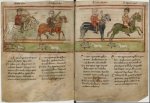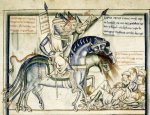Look at Rev. 9:4 the locust were told not to harm the grass of the earth or any plant or tree. Grass comes in a variety of different shades of green, some dark, some pale and some yellowish green.
Green horse?
- Thread starter Willie-T
- Start date
-
Christian Chat is a moderated online Christian community allowing Christians around the world to fellowship with each other in real time chat via webcam, voice, and text, with the Christian Chat app. You can also start or participate in a Bible-based discussion here in the Christian Chat Forums, where members can also share with each other their own videos, pictures, or favorite Christian music.
If you are a Christian and need encouragement and fellowship, we're here for you! If you are not a Christian but interested in knowing more about Jesus our Lord, you're also welcome! Want to know what the Bible says, and how you can apply it to your life? Join us!
To make new Christian friends now around the world, click here to join Christian Chat.
Ever seen a horse just blend into the background of the grass he was feeding in.... and just disappear from view? Let's try not to be silly. I am serious about not only why John would call a horse "green", but why the KJV translators chose to use a different word than he did. I'm sure he had the word "pale" available to him, if that is the color he meant to convey.
Not to be mean but, have you ever seen a green horse? Would a green horse camouflage itself in grass? Nobody knows.
My point is that chloros is used to describe grass, therefore chloros is not just one shade of green, therefore chloros can mean a pale green or yellowish green.
Not to be mean but, have you ever seen a green horse? Would a green horse camouflage itself in grass? Nobody knows.
Not to be mean but, have you ever seen a green horse? Would a green horse camouflage itself in grass? Nobody knows.
I don't know why he called it GREEN. But, he did. And I won't change green to pale just to try to make that word fit some preconceived notion about what a horse with a rider called "Death" must have to look like.
Why is one of the horses in Revelation called "Green"? The Greek word is “chloros”, and simply means green. Is there anything in the world such as a "green" horse?
So, some people substitute "pale"? In your opinion, Why?
So, some people substitute "pale"? In your opinion, Why?
.
.
.
.
.
.
.
.
Body Decomposition Timeline
24-72 hours after death — the internal organs decompose.
3-5 days after death — the body starts to bloat and blood-containing foam leaks from the mouth and nose.
8-10 days after death — the body turns from green to red as the blood decomposes and the organs in the abdomen accumulate gas.
Several weeks after death — nails and teeth fall out.
1 month after death — the body starts to liquify.
I hope that helps
Blessings
Bill
Last edited:
Since no-one has yet mentioned the connection, I will, because throwing a monkey wrench in the works is something I do on occasion. 
The four horses are described as being white, red, black and green (and I would have to agree with Willie: green means green). Consider the colours on the flags of the Islamic nations. For the middle-Eastern nations, you will find some combination of white, red, black and green. I will give credit for this idea to Walid Shoebat, and I'll let you draw your own conclusions.

The four horses are described as being white, red, black and green (and I would have to agree with Willie: green means green). Consider the colours on the flags of the Islamic nations. For the middle-Eastern nations, you will find some combination of white, red, black and green. I will give credit for this idea to Walid Shoebat, and I'll let you draw your own conclusions.

Since no-one has yet mentioned the connection, I will, because throwing a monkey wrench in the works is something I do on occasion. 
The four horses are described as being white, red, black and green (and I would have to agree with Willie: green means green). Consider the colours on the flags of the Islamic nations. For the middle-Eastern nations, you will find some combination of white, red, black and green. I will give credit for this idea to Walid Shoebat, and I'll let you draw your own conclusions.
The four horses are described as being white, red, black and green (and I would have to agree with Willie: green means green). Consider the colours on the flags of the Islamic nations. For the middle-Eastern nations, you will find some combination of white, red, black and green. I will give credit for this idea to Walid Shoebat, and I'll let you draw your own conclusions.
That is quite interesting.... and eye-opening.
[HR][/HR][HR][/HR]
Pan-Arab colors
From Wikipedia, the free encyclopedia
[/SUP]
The four colours derived their potency from a verse by 14th century Iraqi poet Safi Al-Din Al-Hilli: "White are our acts, black our battles, green our fields, and red our swords".[SUP][5][/SUP]
interesting
I believe the horse is like a living symbol, it's has phiyical being and it's symbolic. It can be called pale green or just pale and still be correct if you trust things like strings concordance and young's literal translation.
I suspect you mean Strong's concordance, which is essentially a dictionary showing how words were used in the King James version. Given that, it is a poor reference for the meaning of a word as used outside the KJV.
Strong's concordance links the English of the KJV to the original Greek or Hebrew and give a definition of the Greek or Hebrew word, the definition being credible is the point of focus.




